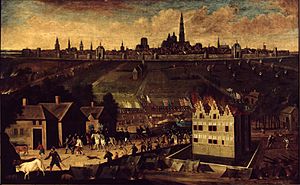Maarten van Rossum facts for kids
Maarten van Rossum (born around 1478 – died June 7, 1555) was a very skilled military leader from a region called the Duchy of Guelders. He became a top military commander, known as a field marshal, serving Charles, Duke of Guelders. People outside Guelders were quite afraid of him because of his tough way of fighting wars.
He often used his famous motto: "Burning and torching is the jewel of war." His fighting style was a bit like the Italian condottieri, using surprise attacks and not always avoiding harm to regular people. For about 30 years, he helped the Dukes of Guelders try to keep their land independent from the powerful Habsburg Netherlands ruled by Emperor Charles V.
Maarten van Rossum won many battles using clever tricks, brave moves, and sometimes by destroying property and harming civilians. After the Duchy of Guelders lost its independence, he even fought for his old enemy, Emperor Charles V, against France in his final years.
Contents
Who Was Maarten van Rossum?
Maarten van Rossum was born in a town called Zaltbommel. His parents, Johan van Rossum and Johanna van Hemert, were part of the lower nobility, which means they were from important families but not royalty. During his life, Maarten gained many important titles. He became the lord of several places like Poederoijen and Bredevoort. He was also the field marshal of Guelders and a governor, or stadholder, of Luxembourg.
He was known as a very experienced commander. He became famous for his actions while serving Charles of Guelders. He fought in the Guelders Wars against Emperor Charles V. He is also remembered for his part in attacking and looting The Hague in 1528.
Fighting for Guelders
After Charles II, Duke of Guelders passed away, van Rossum promised to support the new duke, William, Duke of Jülich-Cleves-Berg. In the last part of the Guelders wars, Maarten van Rossum helped Guelders form an alliance. They teamed up with the kings of France (Francis I of France) and Denmark (Christian III of Denmark). This alliance gave van Rossum a chance to launch a major attack against the Habsburgs.
He planned an attack on the Duchy of Brabant, which was a very important area for the Habsburgs. Van Rossum gathered a large army of more than 15,000 soldiers in the south of Guelderland. The war officially began on July 15, 1542. He then marched into Brabant, where his army burned much of the countryside.
The Brabant Campaign
Van Rossum had first planned to cross the Meuse River near Maastricht and then travel west towards Leuven. However, these plans were discovered by Mary of Hungary, who was a powerful ruler. This forced the Guelders army to cross the Meuse River near Nijmegen instead.
The Guelders army marched through a region called De Peel. They looted and burned villages along their way. They plundered a town called Rode, which is now Sint-Oedenrode. The local church was not spared, and the village was burned down. On July 26, 1543, he attacked and burned the village of Vught.
After failing to capture the cities of Lier and Leuven, his army moved towards Antwerp. At that time, Antwerp was the most important trading city in Western Europe. Van Rossum laid siege to this city. In a battle near what is now Brasschaat, he defeated an army led by René of Chalon, who was the Prince of Orange. About 2,000 Habsburg soldiers were killed in this battle. Van Rossum had cleverly hidden his foot soldiers behind his cavalry, called 'Black riders'. The Habsburg army attacked the cavalry without noticing the hidden infantry.
Before and after his victory, van Rossum completely burned the areas around Antwerp and Leuven. People at the time said that the land around Antwerp remained rural throughout the 16th century because of this destruction. However, van Rossum did not manage to capture the important cities of Lier, Leuven, or Antwerp. An attack on the walls of Antwerp was stopped.
Public Opinion and Legacy
In 1542 and 1543, many pamphlets were printed in Antwerp about the Brabant campaign. People wondered who was worse: Martin Luther or Maarten van Rossum. Those who were directly affected by van Rossum's attacks naturally saw him as the greater evil. However, a poet from Antwerp named Anna Bijns believed that Martin Luther's actions were much more harmful. She wrote that van Rossum harmed bodies, but Luther destroyed souls.
In the spring of 1555, van Rossum became very ill. He might have caught the Black Death or typhus in the city of Charlemont. He died in Antwerp on June 7, 1555. His body was buried in his birthplace, the village of Rossum.
See also
 In Spanish: Maarten van Rossum para niños
In Spanish: Maarten van Rossum para niños




